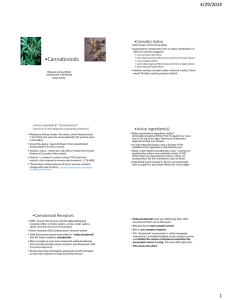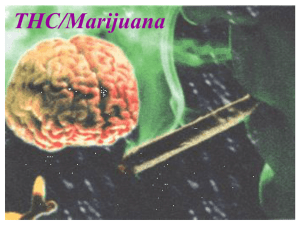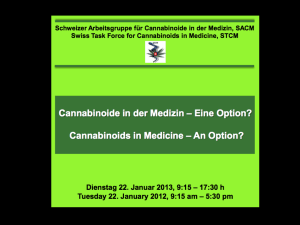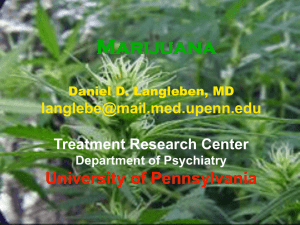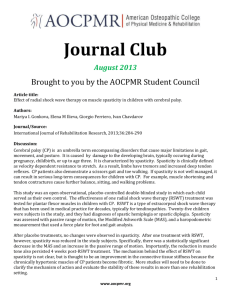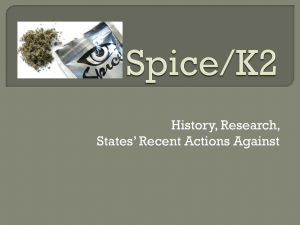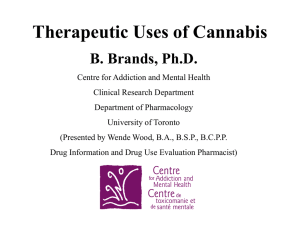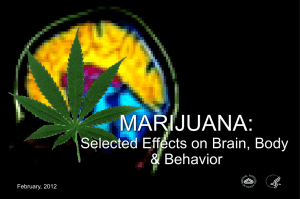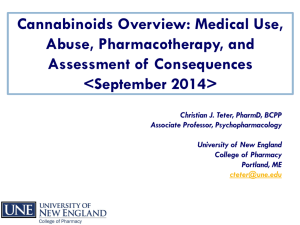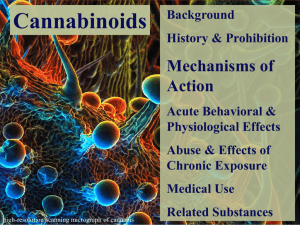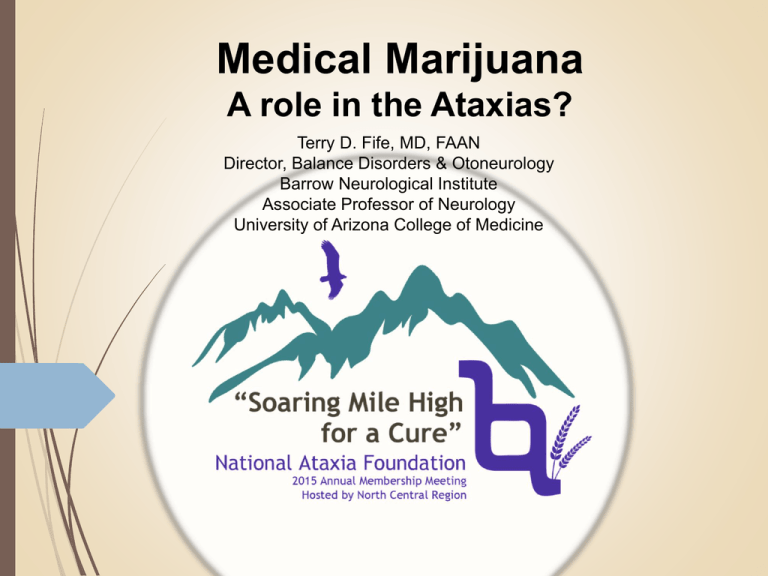
Medical Marijuana
A role in the Ataxias?
Terry D. Fife, MD, FAAN
Director, Balance Disorders & Otoneurology
Barrow Neurological Institute
Associate Professor of Neurology
University of Arizona College of Medicine
Disclaimer
The information provided by speakers in any
presentation made as part of the 2015 NAF Annual
Membership Meeting is for informational use only.
NAF encourages all attendees to consult with their
primary care provider, neurologist, or other health
care provider about any advice, exercise,
therapies, medication, treatment, nutritional
supplement, or regimen that may have been
mentioned as part of any presentation.
Products or services mentioned during these
presentations does not imply endorsement by NAF.
Presenter Disclosures
Dr. Fife has no financial relationship with any
manufacturer of any commercial product
and/or provider of commercial services
discussed in this CME activity.
Dr. Fife will discuss the evidence of cannabinoid
use in neurological conditions for which there is
not an FDA-designated indication.
Objectives
Be familiar with formulations of cannabinoids
Develop a reasonable understanding of the
evidence regarding use of various
cannabinoids in neurological diseases and
ataxia syndromes
Be aware of a few of the legal issues
associated with use of cannabinoids in
medical care
The plant: Cannabis sativa
Many active chemical constituents: THC
(psychoactive), and cannabidiol (not
psychoactive)
Hemp is fiber made from the stem of the plant
and used for clothing and paper but has no
medicinal value.
Brain has endocannabioids
which are our body’s own
molecules that bind to
cannabinoid receptors
(named CB1 and CB2).
CB1 – in CNS mainly
hippocampus and
cerebellum, basal ganglia,
limbic system, prefrontal
cortex.
CB2 – located on immune
cells
Controversies of Medical Marijuana
Accounts for 75% of illegal drug use in U.S.
Two cannabinoids approved by FDA in 1985:
Marinol® (Schedule III) and Cesamet™ (Schedule II).
Herbal (plant) marijuana remains illegal
FDA Schedule I drug since President Nixon signed the
Controlled Substance Act in 1970 as a prelude to the
“war on drugs” declaration.
Federal Law on Marijuana
Controlled Substances Act (CSA) which was
signed into law as the Comprehensive Drug Abuse
Prevention and Control Act of 1970 placed
marijuana and its derivatives as Schedule I.
So what does the science tell us?
Methods
A systematic review of published literature
broadly related to neurological conditions, 19472013
1590 Articles, 61 relevant, 23 were RCT meeting
criteria, 9 were Class I
Literature Classified on the basis of potential
for bias (RTC), only Class I, II and III considered.
Questions to Answer
1. What is the efficacy of cannabinoids in relieving
spasticity in patients with MS?
2. What is their efficacy in relieving central pain and
painful spasms in MS?
3. What is their efficacy in alleviating bladder
dysfunction in MS?
4. What is their efficacy in controlling involuntary
movements including tremor in MS?
5. What is their efficacy in reducing dyskinesias of
Huntington’s disease, levodopa-induced
dyskinesias of Parkinson’s disease, and tics of
Tourette’s syndrome?
6. What is their efficacy in reducing seizure
frequency in epilepsy?
Spasticity from MS
Cannabis extract/THC and Sativex
probably effective in patient-reported
(VAS/NAS) spasticity (4 Class I studies)
Cannabis extract/THC probable
ineffective for physician-assessed
(Ashworth scale) spasticity (3 Class I
studies)
Smoked marijuana is of uncertain benefit
in MS related spasticity (2 conflicting Class
III studies).
Spasticity from MS
Oral cannabis is established as effective to
reduce patient-reported symptoms of
spasticity over six weeks (Level A).
Sativex® and THC are probably effective
in reducing patient reported symptoms of
spasticity over six weeks (Level B).
Inhaled marijuana is of uncertain effect in
reducing spasticity (Level U).
Medically refractory central pain in MS
Based on 5 Class I studies, 3 Class II studies:
Oral cannabis extract is established as
effective to reduce central pain of MS that
has failed standard therapy (2 Class I studies),
(Level A).
THC or nabiximols are probably effective to
reduce central pain or painful spasms of MS
that has failed standard therapy (1 Class I
study each), (Level B).
Bladder symptoms in MS
Based on 4 Class I studies, 1 Class II studies:
Nabiximols probably effective decreasing
number of bladder voids at 10 weeks
(Level B).
THC / oral Cannabis probably ineffective
in reducing bladder complains (Level B).
Nabiximols of uncertain effectiveness for
overall bladder symptoms (Level U).
MS-related tremor
Based on secondary outcome measures in 2
Class I studies, 2 Class II studies:
No benefit in tremor reduction, possibly
worsens
THC / oral cannabis extract should not be
offered for MS-related tremor (Level B).
Involuntary movements
Huntington’s chorea: 2 Class I studies using CBD but
with different rating scales, underpowered.
Benefit with secondary outcome of chorea (1
study), behavioral features (1 study). Possible
modest benefit in chorea (Level B)
Levodopa-dyskinesias in PD: 1 Class I study using
THC was ineffective (Level B)
Tourette’s syndrome: 1 Class I, 1 Class II study,
conflicting data that is overall insufficient
evidence of CBD in reducing tics (Level U)
Seizure frequency in epilepsy
No Class I-III studies using cannabinoids for seizure
frequency in epilepsy. All studies Class IV. No
recommendation for use (Level U)
Answers to Questions
1. Refractory spasticity in patients with MS?
Subjective improvement – YES
Objective improvement – NO
1. Refractory central pain and painful spasms in
MS? YES
2. Bladder dysfunction in MS? NO (mostly)
3. Tremor in MS? NO
4. Dyskinesias of HD, dopa-dyskinesia in PD, Tics
in Tourette’s syndrome? MOSTLY NO (possible
modest reduction of chorea in HD)
5. Seizure frequency in epilepsy? Unknown
So where does that leave us?
Answer: in need of more study.
So why is it taking so long?
Answer: politics, opinions, ideologies
Some Thoughts
Disclaimer: We do not have answers to very
many questions so these are my thoughts for
what they are worth…
When you might consider marijuana or cannabinoids:
•
•
•
•
•
•
Pain that has failed all conventional therapies
Excessive weight loss or loss of appetite
Nausea or motion sensitivity failing other Tx
Anxiety, extreme emotional distress failing other Tx
Excessive spasticity or muscle tone failing other Tx
Oscillopsia (jittery vision) from nystagmus
When you might want to avoid marijuana or cannabinoids
if you have:
• Memory or cognitive dysfunction
• Ataxia – it might worsen balance, speech
• Periods of confusion, hallucinations, disorientation
Consider the following healthful approaches:
•
•
•
•
Minimize sedating and non-essential drugs
Well-balance diet, hunger is permitted
Exercise – how to achieve depends on health
Engage with others socially, intellectually

